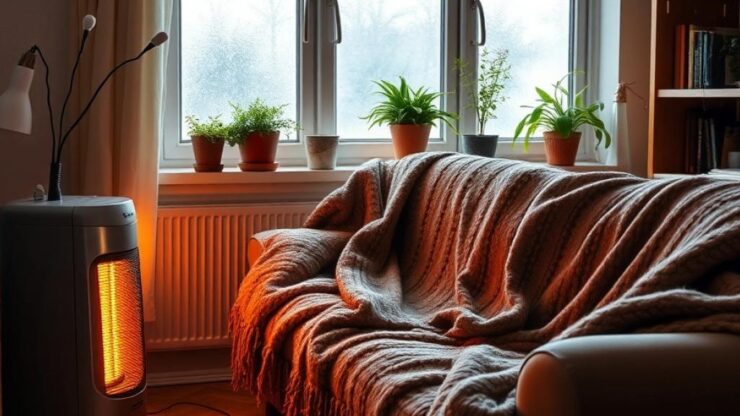Energy-Efficient Heating Systems

As winter approaches, the battle to keep homes warm while managing energy costs becomes a top priority for many households. Energy-efficient heating systems can significantly reduce heating expenses, making them an essential consideration for frugal homeowners. By choosing the right system, you not only save money but also contribute to environmental sustainability.
When it comes to energy-efficient heating, several systems stand out for their effectiveness and cost savings. Here, we’ll explore these systems, discussing their benefits and how they compare to traditional heating methods. Understanding these options can guide you in making an informed decision for your home.
- Heat Pumps: These systems transfer heat rather than generate it, providing efficiency ratings that can be over 300%. They can both heat and cool your home, making them a versatile choice.
- High-Efficiency Furnaces: Modern furnaces can achieve efficiency ratings of 90% or higher. Opting for a high-efficiency model ensures that more of your energy costs are used for heating, rather than wasted.
- Radiant Floor Heating: This system offers comfort by heating the floor directly, reducing the need for higher thermostat settings. It’s particularly effective in bathrooms and kitchens.
- Wood and Pellet Stoves: These provide a renewable and often less expensive heating option, especially if you have access to wood or pellets. They can also serve as a secondary heat source.
- Solar Heating: While the initial investment can be high, solar heating systems can significantly lower energy bills in the long run, especially in sunny regions.
Choosing an energy-efficient heating system not only saves money but also reduces your carbon footprint. Below is a comparative table showcasing the average efficiency and potential savings of various heating systems:
| Heating System | Average Efficiency (%) | Estimated Annual Savings ($) |
|---|---|---|
| Heat Pumps | 300+ | $500-$1,200 |
| High-Efficiency Furnaces | 90-98% | $300-$800 |
| Radiant Floor Heating | 80-90% | $200-$600 |
| Wood/Pellet Stoves | 70-85% | $100-$300 |
| Solar Heating | 50-80% | $400-$1,000 |
Investing in an energy-efficient heating system can lead to substantial savings over time. Understanding your options and their respective benefits helps you make choices that are not only financially savvy but also environmentally responsible.
Insulation and Draft Prevention Techniques
As temperatures drop and winter sets in, ensuring your home remains warm and inviting becomes increasingly critical. However, the challenge of maintaining comfort while keeping energy costs at bay can be daunting. One of the most effective strategies to achieve this balance lies in the realm of insulation and draft prevention. By focusing on these crucial elements, homeowners can create an environment that not only retains heat but also minimizes energy expenditure.
Insulation plays a pivotal role in maintaining thermal comfort within your home. It acts as a barrier against heat loss, ensuring that the warmth generated by your heating system remains where it is needed most. Various types of insulation materials are available, each offering unique benefits. Understanding these options is essential for making an informed decision.
- Fiberglass Insulation: Widely used due to its affordability and effectiveness, fiberglass insulation comes in batts or loose-fill forms, making it suitable for attics, walls, and floors.
- Foam Board Insulation: This rigid insulation is ideal for exterior walls and basements, providing a high insulation value with a thin profile.
- Spray Foam Insulation: Known for its superior air-sealing properties, spray foam expands upon application and fills small gaps, making it perfect for hard-to-reach areas.
Incorporating these insulation types can significantly enhance your home’s energy efficiency, ultimately reducing your heating costs over time.
While effective insulation is crucial, it is equally important to address any drafts that may compromise your efforts. Drafts can occur around windows, doors, and even electrical outlets, allowing cold air to infiltrate your living space. Sealing these gaps is a straightforward and cost-effective method to bolster your home’s warmth.
Consider the following techniques to prevent drafts:
- Weather Stripping: Applying weather stripping around doors and windows can create a tight seal, preventing cold air from seeping in.
- Caulking: For stationary components, such as window frames and baseboards, caulk can fill cracks and gaps that may compromise insulation.
- Draft Stoppers: These simple devices can be placed at the base of doors to block cold air from entering, providing an immediate solution to draft issues.
By implementing these draft prevention techniques, homeowners can enhance their comfort and reduce reliance on heating systems, leading to further savings on energy bills.
Utilizing Alternative Heating Sources
As homeowners continue to seek innovative ways to combat winter’s chill without breaking the bank, the exploration of alternative heating sources has gained traction. These methods can complement traditional systems, providing both warmth and savings, while reducing reliance on conventional fuels. By diversifying your heating strategy, you not only enhance comfort but also create a more resilient and efficient home heating plan.
Alternative heating sources can vary widely in terms of cost, efficiency, and installation requirements. Each option presents unique benefits that can suit different lifestyles and home setups. Whether you’re looking for renewable energy solutions or simply a more cost-effective method to stay warm, understanding these alternatives is essential.
One of the most sustainable ways to heat your home is through renewable energy sources. Utilizing these options can significantly lessen your environmental impact while simultaneously lowering heating costs. Here are a few noteworthy alternatives:
- Biomass Heating: Utilizing organic materials such as wood pellets, agricultural crops, or even waste can provide a renewable heating solution. Biomass systems can be highly efficient and reduce dependence on fossil fuels.
- Solar Thermal Heating: This method harnesses the sun’s energy to heat water, which can then be circulated through your home. Although the initial investment can be substantial, the long-term savings on energy bills make it a compelling choice.
- Geothermal Heating: By tapping into the Earth’s stable underground temperatures, geothermal systems can provide heating and cooling efficiently. They require a higher upfront cost but offer significant energy savings over time.
In addition to larger systems, portable heating devices can offer flexible and cost-effective solutions to keep specific areas of your home warm. Utilizing these devices strategically can contribute to overall energy savings. Consider the following options:
- Electric Space Heaters: Ideal for warming individual rooms, these devices can reduce the need for central heating in unused spaces, leading to lower energy consumption.
- Infrared Heaters: These heaters provide instant warmth by emitting infrared radiation, allowing for targeted heating without the need to heat an entire room.
- Propane or Natural Gas Heaters: Often used as supplemental heat sources, these heaters can be efficient for spaces that require extra warmth during extreme cold spells.
Incorporating alternative heating sources into your winter heating strategy not only promotes efficiency but also aligns with a frugal approach to managing energy bills. By diversifying your heating methods, you can enjoy a warm, inviting home even during the coldest months while remaining budget-conscious.
Smart Thermostats and Energy Management
In the quest for a cozy home during the frigid winter months, smart thermostats emerge as a pivotal tool in the realm of energy management. These innovative devices not only allow homeowners to control their heating systems remotely but also enable advanced programming that can lead to significant energy savings. By optimizing heating schedules according to individual lifestyles, smart thermostats can keep your home warm when you need it most while minimizing energy usage during off-peak hours.
Modern smart thermostats come equipped with a plethora of features designed to enhance comfort and efficiency. For instance, many devices utilize learning algorithms that adapt to your heating preferences over time, automatically adjusting settings based on occupancy and historical data. This leads to a more personalized heating experience without the need for constant manual adjustments. Furthermore, some models offer geofencing capabilities, which use your smartphone’s location to determine whether you’re home or away, ensuring that your heating system operates only when necessary.
Another exciting aspect of smart thermostats is their ability to provide real-time energy usage data. By presenting insights into your heating patterns, these devices empower you to make informed decisions about your energy consumption, allowing you to identify opportunities for further savings. For instance, you may discover that lowering the thermostat by just a few degrees during the night can lead to substantial reductions in energy bills.
When considering the integration of smart thermostats into your home heating strategy, it is essential to evaluate the various options available in the market. Below is a comparative table highlighting key features of popular smart thermostat models:
| Model | Learning Capability | Geofencing | Energy Reports |
|---|---|---|---|
| Thermostat A | Yes | Yes | Monthly |
| Thermostat B | No | Yes | Weekly |
| Thermostat C | Yes | No | Monthly |
By assessing these features, homeowners can select a smart thermostat that aligns with their specific heating needs and preferences, ultimately leading to a more efficient heating strategy.
Cost-Effective Maintenance and Repairs
As winter approaches, many homeowners focus on enhancing their heating systems, but often overlook the importance of regular maintenance and timely repairs. Effective maintenance not only ensures that your heating system operates efficiently but can also prevent costly breakdowns during the coldest months. By adopting a proactive approach to maintenance and repairs, you can extend the lifespan of your heating system, optimize energy consumption, and keep your home warm without overspending.
Implementing a routine maintenance schedule can significantly reduce heating costs and enhance comfort levels. Regular checks and minor repairs can prevent larger, more expensive issues from arising. Here are some essential maintenance practices:
- Filter Replacement: Regularly changing or cleaning filters can improve airflow and efficiency, reducing energy consumption by up to 15%.
- System Inspections: Annual inspections by a qualified technician can identify potential issues before they escalate, ensuring your system runs smoothly.
- Thermostat Calibration: Ensuring your thermostat is set correctly can improve heating efficiency. An improperly calibrated thermostat can lead to inconsistent temperatures and unnecessary energy use.
- Duct Cleaning: Over time, dust and debris can accumulate in ducts, diminishing system efficiency. Routine duct cleaning helps maintain optimal airflow.
- Check Insulation: Evaluating and updating insulation in key areas, such as attics and basements, can prevent heat loss and reduce the workload on heating systems.
Ignoring minor issues can lead to major expenses down the line. Being attentive to signs that indicate repairs are needed can save you from costly emergencies. Here are a few warning signs to watch for:
- Inconsistent Heating: If certain rooms remain cold, it could signify duct issues or problems with the heating unit.
- Strange Noises: Unusual sounds from your heating system often indicate that components are failing and should not be ignored.
- Increased Energy Bills: A sudden spike in your heating bills may suggest inefficiencies in your system, necessitating immediate attention.
To illustrate the financial benefits of regular maintenance versus emergency repairs, consider the following comparison:
| Action | Average Cost | Long-Term Savings |
|---|---|---|
| Annual Maintenance Check | $100-$200 | Can save up to $500 in repairs |
| Filter Replacement | $10-$30 | Can save $100 in energy costs |
| Duct Cleaning | $300-$500 | Can save $200 in heating costs |
Investing in maintenance not only enhances comfort but also translates into substantial savings over time. By prioritizing regular upkeep and addressing repairs promptly, homeowners can enjoy a warm, efficient home throughout winter without straining their budgets.
Disclaimer
This article has been created or edited with the support of artificial intelligence and is for informational purposes only. The information provided should not be considered investment advice. Please seek the support of a professional advisor before making any investment decisions.






